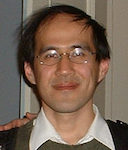Chen-Pang Yeang
My research areas are the history of physics and the history of technology from the late nineteenth century to the present. I focus on how science and engineering have shaped each other at the levels of mathematical structures, physical theories, experimentation, instrumentation, and the development of new technologies. I am particularly interested in issues related to the production, justification, circulation, application, and transformation of technical knowledge in the mutual shaping between science and engineering. I also pay close attention to the different meanings and functions of technical knowledge to distinct professional or intellectual communities.
Along this direction, I have been undertaking six research projects:
• Conceiving Noise: From Fin de Siècle to the Information Age
• Studies of Wave Propagation and the Emergence of Active Sensing
• Transformation of Electromagnetic Waves from a Novel Effect to a Research Object, 1887-1901
• Chao Yuen Ren and the Modern Soundscape of Republican China, 1912-1937
• The Very Recent History of Quantum Information
• Amateurs’ Knowledge in Cutting-Edge Technological Development: From Radio Hams to Computer Hackers
People Type:
Roles:
Research Area:
“What Heinrich Hertz discovered about electric waves in 1887?” Archives for the History of Exact Sciences, 75:2 (2021), 173-218 (with J.
Buchwald, N. Stemeroff, J. Barton, Q. Harrington).
“Mechanization of hearing in Chao Yuen Ren’s dialect research,
1927-1936: Senses, objectivity, and observation,” Chinese Annals of History of Science and Technology, 3:2 (2019), 94-117.
“From modernizing the Chinese language to information science: Chao Yuen Ren’s route to cybernetics,” Isis, 108:3 (2017), 553-580.
“Kirchhoff’s theory for optical diffraction, its predecessor and subsequent development: the resilience of an inconsistent theory,”
Archives for the History of Exact Sciences, 70 (2016), 463-511 (with J.
Buchwald).
“Two mathematical approaches to random fluctuations,” Perspectives on Science, 24:1 (2016), 45-72.
““Dense Delta-Sigma phased arrays,” IEEE Transactions on Antennas and Propagation, 61:4 (2013), 1825-1837 (with J. Krieger as first author, G.
Wornell).
“The sound and shapes of noise: Measuring disturbances in early twentieth-century telephone and radio engineering,” ICON: Journal of the International Committee for the History of Technology, 18 (2012), 63-85.
“The Maxwellians: The Reception and Further Development of Maxwell’s Electromagnetic Theory,” in Raymond Flood, Mark McCartney and Andrew Whitaker (eds.), James Clerk Maxwell: Perspectives on His Life and Works (Oxford: Oxford University Press, 2014), 204-222.
Probing the Sky with Radio Waves: From Wireless Technology to the Development of Atmospheric Science (Chicago: University of Chicago Press, 2013).
“The sound and shapes of noise: Measuring disturbances in early twentieth-century telephone and radio engineering,” ICON: Journal of the International Committee for the History of Technology, 18 (2012), 63-85.
“From mechanical objectivity to instrumentalizing theory: Inventing radio ionospheric sounders,” Historical Studies in the Natural Sciences, 42:3 (2012), 190-234.
“Engineering entanglement, conceptualizing quantum information,” Annals of Science, 68:3 (2011), 325-350.
“Tubes, randomness, and Brownian motions: Or, how engineers learned to start worrying about electronic noise,” Archives for the History of Exact Sciences, 65:4 (2011), 437-470.
“Dense Delta-Sigma phased arrays,” IEEE Transactions on Antennas and Propagation, 61:4 (2013), 1825-1837 (with James Krieger as first author, Gregory Wornell).
“Scientific fact or engineering specification? The U.S. Navy’s experiments on long-range wireless telegraphy circa 1910,” Technology and Culture, 45:1 (2004), 1-29.
“The study of long-distance radio-wave propagation: 1900-1919,” Historical Studies in the Physical and Biological Sciences, 33:2 (2003), 369-403.
“Towards target recognition from SAR imagery using electromagnetics-based signatures,” Optical Engineering, 42:7 (2003), 2129-2149 (with C. Cho and J. H. Shapiro).
“Quantum theory of second-order soliton based on a linearization approximation,” Journal of the Optical Society of America B, 16:8 (1999), 1269-1279.
“Atmospheric effect on microwave polarimetric passive remote sensing of ocean surfaces,” Radio Science, 34:2 (1999), 521-537 (with S. H. Yueh, K. H. Ding, and J. A. Kong).
“Control Technology—electronic signals,” and “Radio—continuous waves, alternators, valves,” in Colin Hempstead and William Worthington (eds.), Encyclopedia of Twentieth Century Technology, New York: Rutledge, 2004.



